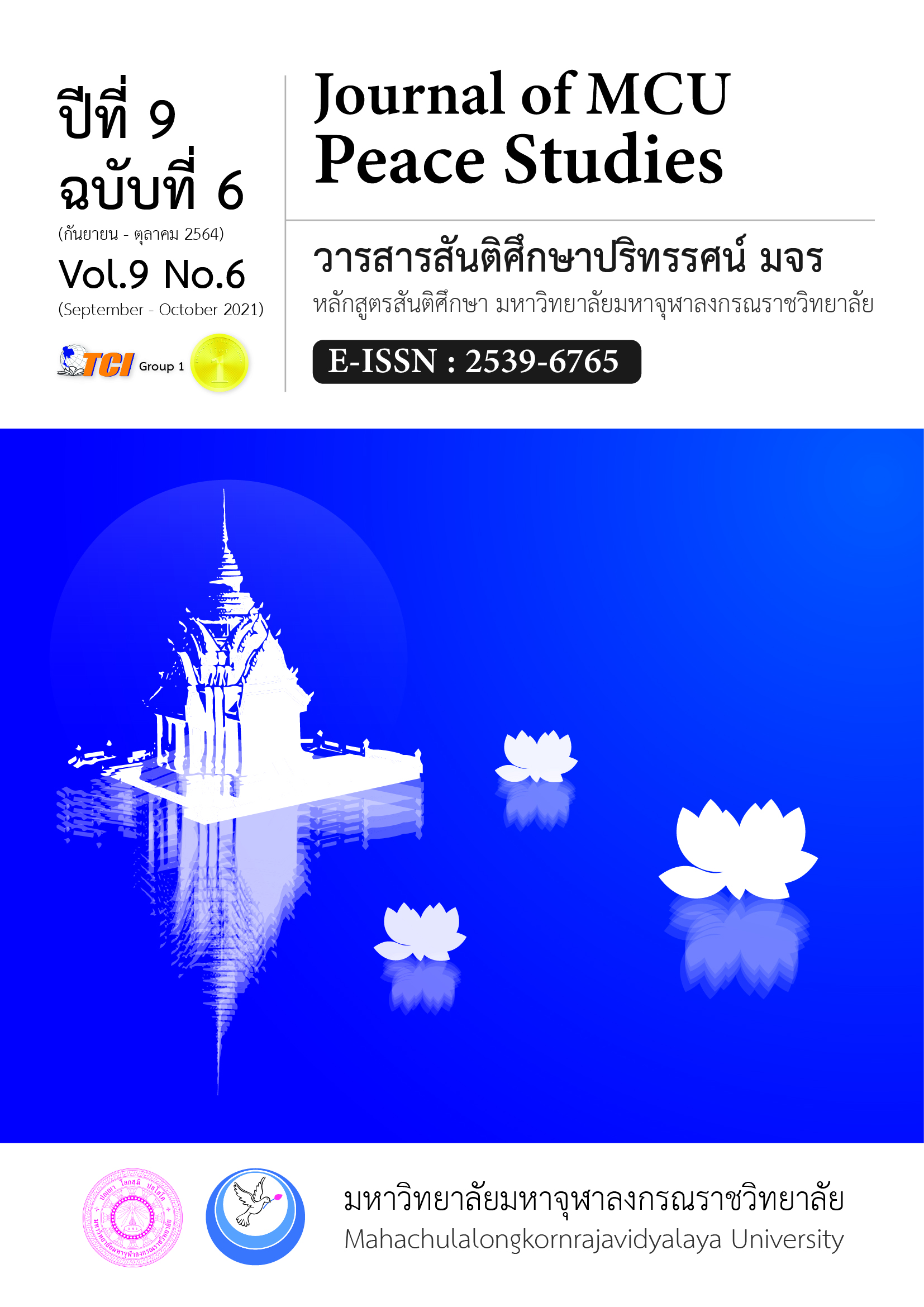การออกแบบกรอบแนวคิดสำหรับการวิจัย เพื่อศึกษาการยกระดับฐานะทางเศรษฐกิจของแรงงานไทย
Main Article Content
บทคัดย่อ
บทความวิจัยนี้มีวัตถุประสงค์เพื่อ 1) ศึกษารูปแบบโครงการวิจัยที่ได้รับทุนจากภาครัฐเพื่อศึกษาการยกระดับฐานะทางเศรษฐกิจของแรงงานไทยในปัจจุบัน 2) จัดทำข้อเสนอแนะกรอบแนวคิดการวิจัยเพื่อการยกระดับฐานะทางเศรษฐกิจของแรงงานไทย จากการศึกษาด้วยวิธีวิทยาการวิจัยเชิงคุณภาพแบบพพุกรณี กับโครงการวิจัยเกี่ยวกับด้านการพัฒนาแรงงานและระบบสนับสนุนเพื่อการพัฒนาศักยภาพและเพิ่มความสามารถการแข่งขันของแรงงานไทยให้ทัดเทียมกับมาตรฐานในระดับอาเซียนจากโครงการวิจัยที่เคยได้รับทุนจากหน่วยงานของรัฐบาลไทยจำนวน 13 โครงการ ผลการวิจัยพบว่า 1) ประเด็นการศึกษาเรื่องการพัฒนาศักยภาพเพื่อเพิ่มความสามารถการแข่งขันของแรงงานไทยให้ทัดเทียมกับมาตรฐานในระดับอาเซียนที่เกิดขึ้นระหว่าง ปี พ.ศ. 2555-2559 มีความสอดคล้องกับองค์ประกอบการพัฒนาเพื่อยกระดับทรัพยากรมนุษย์ ได้แก่ การมีชีวิตที่ยืนยาวและมีสุขภาพดี (ร่างกาย) ความรู้ (ปัญญา) และมาตรฐานคุณภาพชีวิต (ฐานะทางเศรษฐกิจ) 2) ประเด็นเกี่ยวข้องกับการยกระดับมาตรฐานคุณภาพชีวิตหรือฐานะทางเศรษฐกิจของแรงงานไทยยังไม่ได้รับการสนใจมากนักอีกทั้งยังขาดการจัดสรรให้ทุนวิจัยอย่างเป็นระบบในประเด็นนี้ ทั้งที่ประเด็นดังกล่าวเป็นหนึ่งในองค์ประกอบหลักของเป้าหมายการพัฒนาทรัพยากรมนุษย์ไม่ยิ่งหย่อนไปกว่าประเด็นทางด้านร่างกายหรือปัญญา 3) กรอบแนวคิดสำหรับการวิจัยเพื่อศึกษาการยกระดับฐานะทางเศรษฐกิจของแรงงานไทยควรประกอบด้วยการศึกษาเรื่อง การเพิ่มรายได้ การลดหนี้สิน การยกระดับหรือสร้างมาตรฐานอาชีพ การศึกษาเกี่ยวกับแหล่งตลาดงานในภูมิภาค โอกาสการเข้าถึงแหล่งเงินทุน การเข้าถึงพื้นที่อยู่อาศัยและทำกิน ความเข้มแข็งและความสามารถในการแข่งขันระหว่างประเทศ และการหมุนเวียนของกระแสเงินสดที่ไหลเข้าและออกประเทศ
Article Details
ทัศนะและความคิดเห็นที่ปรากฏในบทความในวารสาร ถือเป็นความรับผิดชอบของผู้เขียนบทความนั้น และไม่ถือเป็นทัศนะและความรับผิดชอบของกองบรรณาธิการ ยินยอมว่าบทความเป็นลิขสิทธิ์ของวารสาร
เอกสารอ้างอิง
Abdullah-Al-Shafi, M. (2020). COVID-19 pandemic: a viewpoint from Asia. Bulletin of the National Research Centre, 44, 1-7.
Baker, S. R. (2018). Debt and the response to household income shocks: Validation and application of linked financial account data. Journal of Political Economy, 126(4), 1504-1557.
Bavetta, S., Li Donni, P., & Marino, M. (2019). An empirical analysis of the determinants of perceived inequality. Review of Income and Wealth, 65(2), 264-292.
Bérenger, V., & Verdier-Chouchane, A. (2007). Multidimensional measures of well-being: Standard of living and quality of life across countries. World Development, 35(7), 1259-1276.
Bernstein, A. (2016). Household debt overhang and labor supply. Unpublished Working Paper. Retrieved October 27, 2021, from https://www.haas.berkeley.edu/wp-content/uploads/Asaf_Bernstein_JMP_HouseholdDebtOverhangLaborSupply_201608.pdf
Bhawsar, P., & Chattopadhyay, U. (2015). Competitiveness: Review, reflections and directions. Global Business Review, 16(4), 665-679.
Callander, E.J., Schofield, D.J., Shrestha, R.N., & Kelly, S.J. (2012). Sufficient education attainment for a decent standard of living in modern Australia. Journal of Social Inclusion, 3(1), 7–20.
Christophers, B. (2018). Intergenerational inequality? Labour, capital, and housing through the ages. Antipode, 50(1), 101-121.
Cooke, F. L., Schuler, R., & Varma, A. (2020). Human resource management research and practice in Asia: Past, present and future. Human Resource Management Review, 30(4), 100778.
De Guzman, R., & Malik, M. (2020). Dual challenge of cancer and COVID-19: impact on health care and socioeconomic systems in Asia Pacific. JCO global oncology, 6, 906-912.
Egbu, C.O. (2004) . Managing knowledge and intellectual capital for improved organizational innovations in the construction industry: an examination of critical success factors. Engineering, Construction and Architectural Management, 11(5), 301-315.
Eisner, E.W. (1985). Educational connoisseurship and educational criticism: Their forms and functions in educational evaluation. In E.W. Eisner, The art of educational evaluation: A personal view (pp. 87–102). Philadelphia: The Falmer Press.
Esen, O., & Oğuş Binatlı, A. (2017). The impact of Syrian refugees on the Turkish economy: Regional labour market effects. Social Sciences, 6(4), 129.
Evemy, J., Yates, E., & Eggleston, A. (2020). Monetary Policy as Usual? The Bank of England’s Extraordinary Monetary Policies and the Disciplining of Labour. New Political Economy, 1-19.
Gereffi, G. (2010). The Global Economy: Organization, Governance, and Development. In N.J. Smelser, & R. Swedberg (Eds.), The handbook of economic sociology (pp. 160-182). Princeton University Press.
Israel, K. F., & Latsos, S. (2020). The impact of (un) conventional expansionary monetary policy on income inequality–Lessons from Japan. Applied Economics, 52(40), 4403-4420.
Jagger, C., Gillies, C., Moscone, F., Cambois, E., Van Oyen, H., Nusselder, W., & Robine, J. M. (2008). Inequalities in healthy life years in the 25 countries of the European Union in 2005: a cross-national meta-regression analysis. The Lancet, 372(9656), 2124-2131.
Khanna, A. (2020). Impact of Migration of Labour Force due to Global COVID-19 Pandemic with Reference to India. Journal of Health Management, 22(2), 181-191.
Kruppe, T., & Lang, J. (2018). Labour market effects of retraining for the unemployed: the role of occupations. Applied Economics, 50(14), 1578-1600.
Le Billon, P., Suji, M., Baniya, J., Limbu, B., Paudel, D., Rankin, K., & Shneiderman, S. (2020). Disaster Financialization: Earthquakes, Cashflows and Shifting Household Economies in Nepal. Development and Change, 51(4), 939-969.
Martin, A., Markhvida, M., Hallegatte, S., & Walsh, B. (2020). Socio-economic impacts of COVID19 on household consumption and poverty. Economics of disasters and climate change, 4(3), 453-479.
McKenzie, D. J. (2005). Measuring inequality with asset indicators. Journal of population economics, 18(2), 229-260.
Mehrjerdi, Y.Z., & Shafiee, M. (2021). A resilient and sustainable closed-loop supply chain using multiple sourcing and information sharing strategies. Journal of Cleaner Production, 289, 125141.
Mellqvist, H., Gustavsson, R., & Gunnarsson, A. (2013). Using the connoisseur method during the introductory phase of landscape planning and management. Urban forestry & urban greening, 12(2), 211-219.
Mulang, A. (2015). The importance of training for human resource development in organization. Journal of Public Administration and Governance, 5(1), 190-197.
Nababan, T.S. (2019). Development analysis of global competitiveness index of ASEAN-7 countries and its relationship on gross domestic product. Integrated Journal of Business and Economics, 3(1), 1-14.
Nguyen, P. D., Dang, C. X., & Nguyen, L. D. (2015). Would better earning, work environment, and promotion opportunities increase employee performance? An investigation in state and other sectors in Vietnam. Public Organization Review, 15(4), 565-579.
Office of the National Economic and Social Development Council. (n.d.). Economic and Social Development Plan. Retrieved October 27, 2021, from https://www.nesdc.go.th/main.php?filename=developp_issue.
Robine, J., Saito, Y., & Jagger, C. (2009). The relationship between longevity and healthy life expectancy. Quality in Ageing and Older Adults, 10(2), 5-14.
Santad, P. (2019). Human Resource Development for Working in Thailand 4.0 Era. Journal of Crime and Security, 1(1), 79-88.
Sarania, R. (2015). Impact of self-help groups on economic empowerment of women in Assam. International Research Journal of Interdisciplinary & Multidisciplinary Studies, 1(1), 148- 159.
Selvarajah, C., & Meyer, D. (2017). Human capacity development in Indonesia: leadership and managerial ideology in Javanese organizations. Asia Pacific Business Review, 23(2), 264- 289.
Shu, H., & Xiong, P. (2018). The Gini coefficient structure and its application for the evaluation of regional balance development in China. Journal of Cleaner Production, 199, 668-686.
Sitthiyot, T., & Holasut, K. (2020). A simple method for measuring inequality. Palgrave Communications, 6(1), 1-9.
Strategic Transformation Office. (n.d.). 20 Year National Strategic Plan. Retrieved October 27, 2021, from https://sto.go.th/th/about/policy/20-year-strategic-plan.
United Nations Development Programme. (n.d.). Human Development Reports. Retrieved October 27, 2021, from http://hdr.undp.org/en/2020-report.
United Nations. (2018). Sustainable development goals. Retrieved April 4, 2021, from https://www.undp.org/content/undp/en/home/sustainable-development-goals.html
Vardarlıer, P. (2016). Strategic approach to human resources management during crisis. Procedia-Social and Behavioral Sciences, 235, 463-472.
Zhou, K., Zhang, X., Ding, Y., Wang, D., Lu, Z., & Yu, M. (2015). Inequality trends of health workforce in different stages of medical system reform (1985-2011) in China. Human resources for health, 13(1), 1-8.


